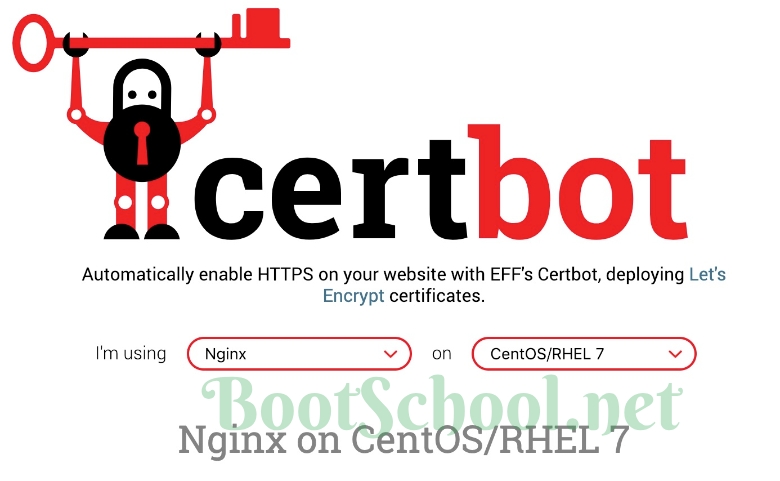1 、安装Let’s Encrypt客户端Certbot
[root@ ~]# yum install epel-release
[root@ ~]# yum install certbot
更多安装方式请参考certbot官网:https://certbot.eff.org/
2、停止Nginx服务
[root@ ~]# nginx -s stop
注意:如果不停止Nginx服务,使用certbot生成SSL证书可能会失败,错误提示如下:
......
Problem binding to port 443: Could not bind to IPv4 or IPv6.
3、使用certbot生成SSL证书
certbot命令格式:
certbot certonly —standalone —email 邮箱地址 -d 域名地址
网站如果有多个子域名时需在后面增加,如:
certbot certonly —standalone —email 邮箱地址 -d 你的域名1 -d 你的域名2
[root@ ~]# certbot certonly --standalone --email "you-email@qq.com" -d example.com -d www.example.com
如果看到类似如下的输出信息则说明生成SSL证书成功
IMPORTANT NOTES:
- Congratulations! Your certificate and chain have been saved at:
/etc/letsencrypt/live/example.com/fullchain.pem
Your key file has been saved at:
/etc/letsencrypt/live/example.com/privkey.pem
Your cert will expire on 2019-03-09. To obtain a new or tweaked
version of this certificate in the future, simply run certbot
again. To non-interactively renew *all* of your certificates, run
"certbot renew"
- Your account credentials have been saved in your Certbot
configuration directory at /etc/letsencrypt. You should make a
secure backup of this folder now. This configuration directory will
also contain certificates and private keys obtained by Certbot so
making regular backups of this folder is ideal.
- If you like Certbot, please consider supporting our work by:
Donating to ISRG / Let's Encrypt: https://letsencrypt.org/donate
Donating to EFF: https://eff.org/donate-le
注意:在执行此步骤时可能会遇到错误提示ImportError: No module named 'requests.packages.urllib3',这是python的模块版本的问题导致,运行如下命令即可解决:
pip install requests urllib3 pyOpenSSL --force --upgrade
pip install --upgrade --force-reinstall 'requests==2.6.0'
4、将证书路劲加入Nginx配置文件Nginx.conf中
server {
listen 80;
server_name example.com www.example.com;
# 所有Http请求转发到Https端口
rewrite ^(.*)$ https://${server_name}$1 permanent;
}
server {
listen 443 ssl;
server_name example.com www.example.com;
# SSL证书路径配置
ssl_certificate /etc/letsencrypt/live/example.com/fullchain.pem;
ssl_certificate_key /etc/letsencrypt/live/example.com/privkey.pem;
# 反向代理到Springboot后台应用
location /{
proxy_pass http://127.0.0.1:8080;
proxy_set_header Host $http_host;
proxy_set_header X-Real-IP $remote_addr;
proxy_set_header X-Forwarded-For $proxy_add_x_forwarded_for;
proxy_set_header X-Forwarded-Proto $scheme;
}
error_page 404 /404.html;
access_log /home/wwwlogs/www.example.com.log access;
}
检查Nginx配置是否修改正确并重新加载配置
[root@ ~]# nginx -t
[root@ ~]# nginx -s reload
一切顺利过后就可以打开浏览器进行测试了
http://www.example.com
或者
https://www.example.com
注意:如果出现无法访问或者空白页,请先检查防火墙是否已经开启了443端口的访问。
5、使用Crontab定时任务自动续订SSL证书(永久免费秘籍)
Let’s Encrypt生成的免费证书有效期为90天,过了就会失效,我们使用Linux系统的Crontab定时任务自动续签证书
[root@ ~]# crontab -e
加入如下内容:
# 每星期1的5点30分执行证书更新操作
30 5 * * 1 /usr/bin/certbot renew >>/var/log/ssl_auto_update.log 2>&1
certbot的续订命令renew将检查系统上安装的所有证书,所有已安装的证书将在到期前30天或更短时间内自动续订和重新加载。
其他资源
Letsencrypt官网: https://letsencrypt.org/
SSL服务器配置生成工具:https://mozilla.github.io/server-side-tls/ssl-config-generator/
SSL安全等级测试网站:https://www.ssllabs.com/ssltest/
